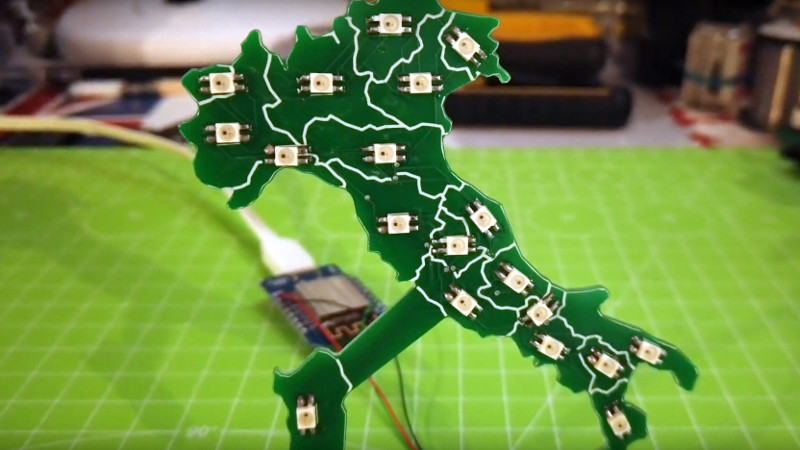While most PCBs stick to tried-and-true methods of passing electrons through their layers of carefully-etched copper, modern construction methods allow for a large degree of customization of most aspects of these boards. From solder mask to number of layers, and even the shape of the board itself, everything is open for artistic license and experimentation now. [Luca] shows off some of these features with his PCB which acts as a live map of Italy.
The PCB is cut out in the shape of the famous boot, with an LED strategically placed in each of 20 regions in the country. This turns the PCB into a map with the RGB LEDs having the ability to be programmed to show any data that one might want. It’s powered by a Wemos D1 Mini (based on an ESP8266) which makes programming it straightforward. [Luca] has some sample programs which fetch live data from various sources, with it currently gathering daily COVID infection rates reported for each of the 20 regions.
The ability to turn a seemingly boring way to easily attach electronic parts together into a work of art without needing too much specialized equipment is a fantastic development in PCBs. We’ve seen them turned into full-color art installations with all the mask colors available, too, so the possibilities for interesting-looking (as well as interesting-behaving) circuits are really opening up.















Why is that PCB shaped like a boot?
So it can “kick little Sicily”
That is a common way to refer to the shape of Italy … “stivale” in italian
Why start this post with: “While most PCBs stick to tried-and-true methods of passing electrons through their layers of carefully-etched copper, modern construction methods allow for a large degree of customization of most aspects of these boards.”.
This makes it sound like you are about to introduce a non standard inter component communications method. But then its just the shape of the board that is changed, which is hardly new.
Modern cutting edge PCB designs are starting to incorporate photonic pathways, hence how misleading the first paragraph is.
I think if its board shape, which is quite a standard part of PCB development and has been for decades, it would be best to remove the first paragraph…
I’ll tell you exactly why that paragraph should remain, it’s because while most PCBs stick to tried-and-true methods of passing electrons through their layers of carefully-etched copper, modern construction methods allow for a large degree of customization of most aspects of these boards. Clear? Good.
The customization of the boards shape, a very old technique, has not changed the method of passing electrons.
This is a semantic argument, but it is worded in a way that suggests that the customization performed departs from that tried and tested method. Despite a change of shape, the electron flow is exactly the same. There has been no novelty added to the electron flow part of this design so that part of this post is a total red herring
So solo che stivale da vino!
Now to reduce it until it can be a substitute for the image of Italy on an Arduino PCB.
The post is not really explaining why this project is cool.
Yes, it’s showing COVID infection rates for each region which would by cool on its own. But the data gets downloaded by the D1 Mini from a Github page managed by the Italian government, and the colors of the leds are part of a color-coded system which is currently in place to manage all the restrictions and other measures against COVID.
So if my region is red I cannot leave my city and I can only go from and to work, if my region is orange I cannot leave my region and I cannot eat at any restaurant or bar, if my region is yellow I can eat lunch at restaurants and bars are open until 6pm, etc. This is so cool because it’s so relevant for the current situation we’re living in and it has a practical use, it’s not just some leds on a pcb shaped like Italy.
So hats off to Luca for the awesome work, keep it up! But for the videos just stick to Italian and English subtitles 🤣
Or at least please don’t read as if you were reading Italian.